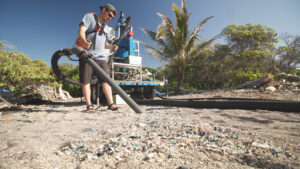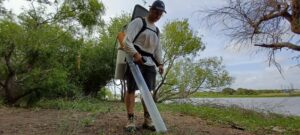
Cleaning up the beach
Canadian Plastics
Canadian Plastics Recycling Research & Development SustainabilityQuebec’s Hoola One Technologies develops innovative vacuum solutions to remove microplastics from sandy beaches and other environments.

Hoola One’s HO Micro prototype beach cleaning device at work. Photo Credit: Hoola One Technologies Inc.
Sometimes the little things are the big problems. Microplastics are a case in point. Fragments of plastic smaller than five millimeters (around the size of a sesame seed), microplastics have a huge number of potential sources – from microbeads in cosmetics to fertilizers and the degradation of larger objects like plastic bags – making them common throughout our environment, being present in the air, food, water, clouds, and even in snow falling from the sky.
As a potential pollution risk, microplastics are outsized: their reported toxic effects can pose a possible threat to human health, and once in the marine environment they can be harmful to fish and other aquatic life, which often ingest them. And much of the remaining water-borne microplastic waste washes up on beaches and coastlines, where it may look at first like sand or other natural materials…until you look more closely. Many beaches are actually covered in little bits of plastic – both on the surface and buried deeper in the sand – and while cleaning the sand manually might seem overwhelming, it can actually make a difference.
Which is the idea behind Hoola One Technologies Inc., a Quebec City-based company that’s developed innovative vacuum technologies that separate microplastics from the sand to restore beaches, and other plastic-polluted areas, to their natural state.
HAWAIIAN INSPIRATION
The origins of Hoola One trace back to 2017, as a final project for a group of 12 mechanical engineering students from the University of Sherbrooke. One of the students saw the problems raised by microplastics at Kamilo Beach on the big island in Hawaii – notorious as one of the world’s worst spots for plastic marine debris – and decided, along with his colleagues, to build a vacuum-like machine that could be used directly on the beach to suck up sand combined with microplastics into a container full of water. The principle of buoyancy did the rest: The sand sank to the bottom of the container while the plastic floated to the surface, where it was directed into filters for collection. The microplastics were then removed and the clean sand put back on the beach. “We did some research and realized there were no other machines in the world capable of doing this kind of job,” said Jean-David Lantagne, the CEO and co-founder of Hoola One, who was one of the students involved. “At that time, the technology for beach cleanup was mostly sieve-style equipment, and it was used primarily at the tourist resorts, not the public beaches and other coastlines.” And even at the resorts, Lantagne said, the sieve-style was problematic. “It can’t remove microplastic that’s smaller than the openings of the sieve, and it’s very intrusive – along with scooping up plastic it removes natural matter that’s actually needed in the ecosystem,” he said.
The students contacted Hawaii Wildlife Fund (HWF), a non-profit organization that runs several beach cleanups in the archipelago, and HWF welcomed the initiative. “They told us that they had no problem in recovering the bigger plastic items from the beaches but that they couldn’t recover the microplastic, so we saw this as our opportunity,” Lantagne said.
After several months of research and testing in Sherbrooke, the team flew to Hawaii in April 2019 to demonstrate their invention in a real-world environment. Trials showed that the device – dubbed the HO Micro – could clean three gallons of sand a minute, and it ultimately collected a whopping 230 pounds of microplastics in two weeks. The students then donated it to HWF, which has been using it ever since.
PERFECTING THE PROTOTYPE
The project’s success led to the formation of Hoola One Technologies later in 2019 by Lantagne and two other members of the initial team, including current co-owner Jean-Felix Tremblay, with financial support from the Canada Economic Development for Quebec Regions (CED) agency, and assistance from Espace-inc, a business accelerator based in Sherbrooke. The company’s name is a tribute to its early success in Hawaii – “Ho’la One” means giving life back to the sand in the Hawaiian language. Built in Hoola One’s headquarters in Quebec City – where the company moved from Sherbrooke in 2021 – the current version of the HO Micro is a four-module machine that’s more efficient at recovering microplastics than other cleaning technologies, Lantagne said, because it scoops up particles that are as small as 0.05 millimeters down to a depth of 7.5 centimeters; is less intrusive to the ecosystem; works on any type of soil; and can be used on rugged shores, where other devices fail.

Using the HO Backpack. Photo Credit: Hoola One Technologies Inc.
In addition to the HO Micro, the company has developed and built two other different, but complementary, vacuum cleaning devices: the HO Wrack, which is Hoola One’s main commercial technology, is a single-module sieving unit that collects plastics within a desired range while returning everything outside of that range to the shore, and which can be used in factories and parks in addition to beaches; and the HO Backpack is a smaller portable collection unit that features a hand-held vacuum device that collects microparticles from areas that aren’t served by roads, and which are then brought back to either the HO Micro or HO Wrack central units. Hoola One plans to bring a new commercial version of the HO Backpack to market in July 2024, and a new version of the HO Wrack to market in December 2024.
BRANCHING OUT
After focusing for several years on beach cleaning and building a customer base among non-profit organizations, beach cleanup groups, and local and federal authorities – including Environment Canada – Hoola One branched out in 2021 into the recovery of spilled resin pellets on outdoor areas of plastics processing and converting plants. “One of the big sources of microplastics is pellets spilled due to plastic production plant leakage or during transportation, and which then find their way into the environment,” Lantagne said. “We’d already noticed during many of our beach cleanups that some of the microplastic material was actually virgin pellets, so this was a natural progression for us.” The HO Wrack system is well-suited for these jobs, Lantagne explained. “It’s the optimal technology for pellet collection; it can access hard-to-reach places outside the plant, like gravel terrain, and recaptures spilled pellets, along with dirt and other matter, and treats them on-site so the pellets can be sold to recyclers,” he said.
From an initial staff of four workers and one intern in 2019, Hoola One now employs eight full-time staff, and plans to hire more in the immediate future. “We’re just beginning a big project that will require some new hires, and we anticipate having about 14 workers by the end of this year,” Lantagne said. “We’re growing very fast, and our plan is to offer our technology in Europe in 2026.”
The success of its vacuum technology aside – and to date Hoola One has won six awards recognizing its work in engineering, entrepreneurship, and innovation – the firm’s growth is probably also helped by new requirements in many jurisdictions for the handling and management of plastic pellets, flakes, and powders throughout the supply chain to prevent spills, leaks, and loss to the environment. “More processors are now obligated to prevent pellet discharges by factories and in resin transport and to clean up the waste that comes from their end products, including microplastics, and we offer proven, ready-made vacuum cleaning solutions to keep not only beaches, but industrial environments free from microplastic pollution,” Lantagne said. “If we can clean up Kamilo Beach, we can clean up anywhere.”
